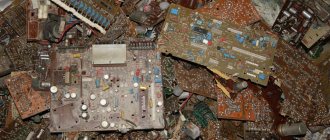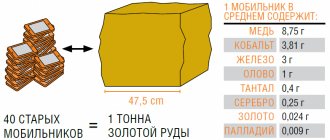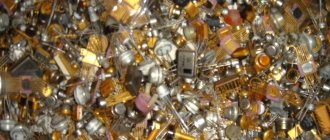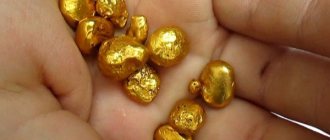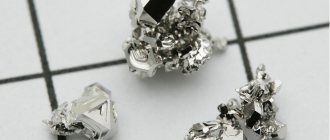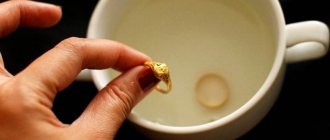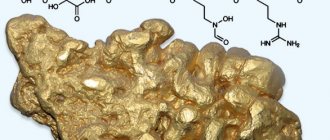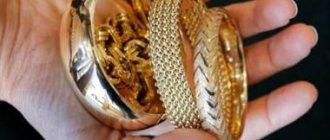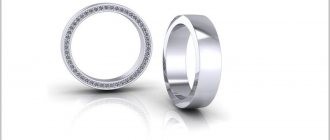How to determine a metal and its origin? The question is mainly of interest to jewelry owners who are afraid of purchasing a fake for an impressive amount. You can deal with this problem yourself or contact an expert. The jeweler will conduct an examination, issue an opinion and charge a fee for the work. Authenticity testing can cost from 10 to 20% of the cost of jewelry. If you can’t contact a specialist, then you should try to solve the problem on your own.
Comparison of platinum, silver and white gold
additional information
St.12Х18Н9 (AISI 304) gives a short spark, colored light yellow with a few red dots appearing from time to time. At the point of contact with the abrasive and at the ends of the branching, the spark beam has a red-yellow color.
St.X12F1 - yellow, short spark, multiple “stars”, the ends are elongated in a line. The area where the abrasive touches is red-yellow. Individual red dots throughout the entire beam.
How to identify non-ferrous metal?
Today, many owners of private houses are trying to make the most of their own capabilities. We are talking about organizing a workshop. The presence of even a primitive lathe will allow you to produce a wide variety of parts for a wide variety of purposes. In any case, repairing garden equipment or even your own car will become much easier.
Meanwhile, savings can be achieved by purchasing metal raw materials on the most favorable terms. Today on the Internet you can find the most attractive prices for aluminum rods. Many people purchase metal for further use at scrap metal sites. Here the question arises - how to distinguish ferrous metal from non-ferrous metal?
The actual difference between ferrous and non-ferrous metals
Surveys show that the average person cannot answer this question. The essence of the answer lies in the composition of the metals.
Ferrous metals contain an admixture of iron. Therefore, ferrous metal can be determined using an ordinary magnet. If it sticks to a metal part or workpiece, we can say with confidence that it is made of ferrous metal.
However, there are exceptions to any rule. Nickel also attracts a magnet, although it is considered exclusively non-ferrous metals. Additionally, the magnet rule does not apply to some metal alloys.
These include stainless steel.
Complex laboratory analysis
You can use nitric acid to test gold without manipulating a touchstone or special needles. To do this, the laboratory takes a sterile metal container into which the gold item being tested is placed. Using a pipette, a small amount of nitric acid is dropped onto the surface. Real gold will not react in any way to this interaction, but other metals will show themselves by changing their shade. Depending on the composition of the item, it may change color to green or milky. A greenish tint indicates that the jewelry is only covered with a layer of gold plating, but its base consists of another metal. And the milky tint says that this is high-quality silver with gilding. But in any case, the jewelry being tested is definitely not made of gold.
Hallmark analysis is not suitable for determining the authenticity of small jewelry; it is more often used when you need to know the quality of gold bars or other massive gold objects. This is due to the fact that during laboratory manipulations, in order to distinguish gold, a piece is sawn off from the product as an analyzed sample. This piece is heated to a very high temperature at which it melts. This gold liquid is then combined with liquid silver and lead. These elemental agents, at the end of a long analysis process, separate and collect the pure gold. The resulting sample is weighed to determine how pure the original sample was.
Today, there are more modern methods of how to accurately distinguish gold from other various metals without causing harm to the product.
In particular, electronic testers can be used. There are units for both laboratories and individuals. True, due to the high cost of these devices, you rarely see them in small pawn shops, much less in someone’s home. The operating method of such electronic testers is based on the use of special liquids to scan a sample. After checking, the device determines the purity of the gold and displays its numerical value on the screen.
An even more expensive method for determining the purity of gold can only be used in professional laboratories, as it involves interaction with X-rays. This complex process allows not only to distinguish pure gold from other metals, but also to obtain a complete report on the composition of the gold alloy. The advantage of this method is that the analyzed jewelry will not be subject to mechanical stress.
Non-ferrous metals that are not magnetic
These can safely be attributed to:
- aluminum;
- copper;
- brass;
- bronze
However, there is an easier way to identify ferrous metal. If you purchase metal at a dealer (reception point), it is very likely that it is located in the open air.
We are talking about the fact that the metal is affected by precipitation. This means that it is in no way protected from corrosion. Consequently, ferrous metals immediately begin to become covered with rust.
Non-ferrous metals are a priori not subject to corrosion (under the influence of the environment). They are protected by an invisible oxide film that appears on the surface.
The video explains how to recognize metal (non-ferrous or ferrous):
Source: euroelectrica.ru
Methods for checking gold items in a store
Particularly difficult is the task of distinguishing gold from other metals with similar external characteristics without leaving the store display. After all, the seller will probably not allow iodine to be dripped onto jewelry, much less scratch its surface in order to get to the bottom of the truth. In this case, you will have to rely on the seller’s honesty and the good name of the jewelry store. But when you are on vacation, for example, in Turkey or Egypt, where you have taken a fancy to some kind of gold jewelry, it is quite difficult to rely on the honesty of the store, since ordinary tourists simply do not know which jewelry chains there can be trusted. Then you need to be vigilant and carefully examine the gold item you are purchasing, at least visually.
What should you pay special attention to? First, study the hallmark, which must be applied to the surface of the jewelry. As a rule, the values are very small and difficult to see with the naked eye, so ask the seller to give you a magnifying glass, or use vision glasses. Study the sample carefully. If you notice that the numbers on the stamp “jump” or their outlines are very illegible, this may indicate that you have a low-quality product. This method of visual analysis will not be able to completely protect you from buying a fake, since only a professional appraiser can do this, but it may stop you from making a quick purchase if in doubt. If you, in principle, could not find a test mark, then you can safely leave the jewelry store, since they are definitely trying to sell you a fake, and a low-quality one at that.
Be sure to ask the seller to demonstrate a quality certificate confirming the composition of the gold alloy, with an exact indication of the alloys included in it and their quantity. Check that the certificate has the seals and signatures of the responsible persons.
When you plan to buy gold jewelry at a pawn shop, second-hand store, or simply secondhand, you should also pay attention to the overall appearance of the jewelry. Make sure that the uniformity of the gold coating is the same in all places. Pay special attention to the edges of the jewelry, as well as where it touches the skin. If you notice that other metal is visible in areas of wear, refuse to purchase as it is not real gold. Most likely this item is made of a different metal and simply has gold plating.
At the same time, if you are dealing with a product made of real gold, the color of its surface may also differ slightly, but precisely in the richness of the golden hue. This is especially true for items consisting of several elements, such as a bracelet or watch. Where the two links meet, the gold surface will be a little brighter. Soldering of products is done using gold solder of a higher standard, since such gold melts more easily. And at the junctions this moment can be noticeable.
Methods for determining metal
Probably everyone had to hold in their hands a piece of jewelry or another object, obviously metal. But how can you determine what metal is used in production? It could be a precious material or a counterfeit, or even a trinket with no claims to value. Expertise from specialists will give you the exact answer, but it is not free. But there are methods for approximately determining the type of metal at home. They were used a long time ago, but they have not lost their relevance in our time.
Similarities and differences
Brass alloy consists mostly of copper, so it is natural that they are similar not only visually, but also in some properties. The more copper in the alloy, the more similar their colors will be. This is where the exact coincidences end.
Visually, less than 80% copper are easily distinguished . They are slightly similar to gold, as they have a pronounced yellow tint. The more zinc, the lighter the shade.
Because of this, brass is even used to counterfeit or imitate gold . Copper has a main shade of reddish, which often has a pink tint.
With a strong decrease in temperature, brass does not lose its relatively limited ductility and does not become brittle . Conducts electricity and heat worse.
They differ in such a way as hardness .
Copper is softer and more ductile , while brass, on the contrary, is hard and it is difficult to give it any shape without annealing.
The shavings are also different: for brass they are needle- shaped , for copper they are twisted into a spiral .
Let's look at the properties that brass and copper have and whether they have any differences:
| Copper | Brass |
| Plastic, soft | Solid |
| Reddish-brown-pink tint | Golden tone |
| Lower sound on impact | Alt |
| Heavy | Easier |
| The shavings are twisted into a spiral | Needle shavings |
Magnet check
Bringing a magnet close to the item being tested is a good way to perform initial testing. By the reaction of the magnet you can determine which group the metal belongs to:
- Ferromagnets. The magnet is clearly attracted to the object, which means that the product may contain iron, steel or nickel.
- Paramagnetic materials. The interaction with the magnet is very weak. This group includes aluminum and chrome. Precious metals that are paramagnetic are platinum, palladium and silver.
- Diamagnets. In general, they do not react to magnets. Copper and zinc have these properties. Precious metals - gold.
Of course, such a check will not allow us to accurately determine the material from which the item is made. After all, a non-magnetic metal may not be in its pure form, but in the form of an alloy with a ferromagnet. But it can confirm or refute the assumption. For example, if it is checked whether it is gold or not, but the item is clearly magnetic, then it can be argued that it is a fake.
When checking jewelry, you should take into account that, in addition to precious metals, they may contain clasps, built-in springs, made of another material. You need to check the metal itself.
Properties of brass and its difference from gold. How brass is disguised as a noble metal
At a quick glance at gold and brass products, it may seem that they are made of the same metal. In fact, upon closer inspection, the difference between the materials will be visible. To do this, you need to pay attention to the main parameters, find out the composition, density, etc. Brass is an alloy of copper with zinc and several alloying components. Zinc is considered essential. The metal comes in two types: two-component and multi-component. Its physical and chemical characteristics:
- density – 8.5-8.7 kg/cm3;
- the metal is not ferromagnetic (but there are exceptions when a ferromagnetic substance is added to the composition during production);
- temperature at which the metal melts: 880-950°C;
- color – yellow with a golden tint;
- high degree of plasticity;
- untreated metal oxidizes upon contact with oxygen;
- corrosion resistance.
Brass exhibits different properties, which are determined by the content of alloying components. The type of products made from such metal depends on this. The main type of raw material for brass production is copper. In terms of strength, such a metal is inferior to many: bronze, but not gold (the latter is softer).
Due to its properties, brass is used in the manufacture of decorative items.
When compared with gold, many differences are noted. But you can only learn about them by taking a closer look at the characteristics. Differences of gold:
- higher temperature at which the metal melts and density;
- bright shine: in comparison, brass also shines, often subdued, but this characteristic manifests itself in different ways, depending on the composition.
There are quite a lot of similar properties between metals, which explains the high risk of buying a fake, since brass can easily be disguised as gold; tricks are used for this:
- a certain number of components are used in production, thanks to them the finished product acquires external characteristics that make brass look like a noble metal;
- applying a decorative coating, for which the gilding technique is used; the brass is first polished.
Heat check
You can also determine the group of a metal by how it conducts heat. It is known that the thermal conductivity of silver is very high. It is almost five times higher than that of iron or platinum. Slightly worse for gold, copper and aluminum. Platinum transfers heat even weaker than iron.
If you immerse the metal in hot water for 15–20 seconds, then based on its temperature, determined by touch, you can draw some conclusions.
- Gold and silver objects will become as hot as the water in which they were dipped.
- During this time, platinum and items containing iron will become warm, but not hot.
In this way it is easy to distinguish platinum from silver. But it’s not possible to compare silver or aluminum alloy.
How to recognize white gold
Another reason to be attentive and cautious: “solar” metal is not only the usual yellow color. It is quite difficult to determine the authenticity of products made of white gold, which an ignorant person can easily confuse with silver. How to be?
Original methods will help you distinguish white gold from silver
| What to do | What result is possible |
| There is another simple method for distinguishing real white gold from silver. To do this, you only need a clean sheet of paper. Slide the decoration over the surface of the paper. | If a gray stripe remains on it, this means that they are trying to sell you silver jewelry. This effect is explained by the fact that the density of silver is softer than that of real gold, which will not “draw” on paper. |
| Another simple cosmetic product such as foundation will come to the rescue. Apply a little foundation to the back of your hand and wait until it is completely absorbed into the skin. Then run the gold jewelry over the area. | When it comes into contact with real gold foundation, a gray stripe will appear on the skin. But if there is none left, then, most likely, you are looking at a piece of jewelry made from brass. |
Also pay attention to the color. In silver it is cold white, but white gold has a warmer tint. If a white gold item is coated with a rhodium layer, then the jewelry will have a barely noticeable bluish glow.
Iodine test
You can check the authenticity of the metal using an iodine solution purchased at a pharmacy. A drop of iodine is applied to the surface and left for several seconds. Iodine will not harm noble metals - gold, platinum, silver. If the color of a drop of iodine does not change, and after removing it with a napkin, no traces or stains remain, this indicates the authenticity of the metal. If darkening is visible at the place of the drop, then this is a low-quality alloy or an outright fake.
Vinegar test
Household vinegar solution also does not affect precious metals. And it is dangerous for counterfeits. But, unlike the iodine test, acetic acid takes time. To wait for the result, you need to immerse the metal being tested in a container with vinegar for 15–30 minutes. The absence of traces of interaction between metal and vinegar is a sign of nobility.
If, in addition to metal, the product contains precious or semi-precious stones, then it is better not to check them this way; vinegar can ruin them. This is especially true for pearls.
Dental check
From novels and films we know that they used to test the authenticity of gold coins by biting them. What exactly can be installed in this “old-fashioned” way? Gold is a soft metal. Therefore, even with a weak bite, a dent from the teeth remains on it. Fake alloys do not have this property; you cannot take them with your teeth.
Such a test gives good results for high-quality products. The higher the pure gold content, the softer it is. Gold of 900 purity and higher is so soft that they try not to expose valuable items made from it to contact with other objects.
Application of chemicals
Testing with active chemical reagents should be left as a last resort. If handled improperly, they will damage even genuine precious metal. And they can be dangerous for the health of the inspector.
Pure gold does not react to ammonia. But practically no products intended for use are made from gold 900 and 999, only for collections. And on a precious metal of lesser purity, ammonia can leave an irremovable mark. Its solution in combination with other substances is used to clean gold items. Therefore, it is not worth identifying gold and silver items using ammonia.
Density check
One of the reliable ways to determine the type of metal or alloy is to determine its density. For pure gold it is two times higher than for copper and almost three times higher than for iron. Platinum is even heavier than gold. Even an alloy of 585 gold is noticeably heavier than base metals.
Of course, to determine the exact density of a small product you will need pharmaceutical scales, volume calculations (Archimedes' law to help) and tabular data on the density of base metals. But to solve the question of what the alloy is mainly made of, gold or another metal, rough estimates are sufficient. If you have at hand an object made of obviously genuine metal of approximately equal volume, then you may not even need a scale. A weight difference of two to three times is not so difficult to catch.
Separately, each of the considered methods will not give an exact answer to the question of what metal the product is made of. But if several different tests show the same results, you can be confident in the correct determination. If not, then you will have to turn to professionals.
Source: dedantikvar.com
Popular laboratory methods for gold analysis
More serious methods of verifying the authenticity of gold jewelry are used in pawnshops and in production. Among the most commonly used laboratory testing methods are the following:
- drip method;
- use of touchstone;
- use of nitric acid;
- assay analysis;
- instrument testing;
- X-ray inspection.
The drop method for testing gold quality is a bit similar to the home method using iodine. But only in the laboratory are more complex chemical solutions used for this purpose. They interact with the ligatures that make up the gold alloy and change their color. Thus, these solutions indicate what alloys (metals) are included in gold and their quantity. For a quality test, not only the chemical solution is important, but also the qualifications of a specialist who wants to distinguish gold from other metals used in the jewelry industry. He must be able to see the slightest differences in color during a chemical reaction.
One of the chemical elements often used to analyze the composition of gold is chlorine. If it is used, the color of gold will take on a different shade - depending on the standard of the precious metal. If during the analysis a green speck appears on the gold surface, this indicates that sample 375 was tested. The most popular 585 yellow or red gold is characterized by the appearance of a light brown speck. But on white gold of a similar standard, during a chemical reaction, a spot of a golden hue or orange color will appear.
To determine the quality of gold jewelry, many pawnshops use a touchstone - a black block with a rough surface.
It is a fine-grained siliceous shale. To check the quality of a gold product, the specialist first rubs the touchstone with almond oil and wipes it dry using special filter paper. Then he draws a one and a half centimeter line on the surface of the touchstone with the gold jewelry. After this, the specialist applies strokes to the stone with special needles indicating the gold standard. After this, he applies a little nitric acid across all the strokes. During the chemical reaction, the alloys begin to oxidize, and the lines acquire different colors, by which the quality of the analyzed gold object is judged.
The colors obtained from the strokes of the assay needles are compared with the color of the stroke of the gold product. With which of the strokes the color matches, that sample will be the analyzed gold object. If the shade of the line left by the item being tested on the touchstone is darker than the shade of the matching needle, there is reason to be wary. This means that the sample applied to the surface of the jewelry being tested is actually lower than specified. If the color of the line does not coincide with any of the other lines, it means that the product being tested is not made of gold, but of another metal.
Precious metal shades
How to determine the type of metal at home?
Recycling and reusing items such as plastic bottles, worn-out clothing and newspapers is very important and forms part of everyday life, helping to increase your contribution to the green movement. One segment of the recycling industry that may not be as popular, but is no less important, is scrap metal recycling. The export of scrap metal is widespread in the Russian Federation and, by processing metal, we reduce the volume of ore production throughout the world.
Some of these metals include copper, steel, aluminum, iron and wire, but are often simply thrown into the trash due to a lack of knowledge and sources of metal recycling. We are here to help educate the public about the possibilities of collecting certain metals and taking them to the right place.
Scrap metal recycling makes money
What many people don't know is that most scrap metal can be recycled for a fee at local scrap metal collection points across the country, thus joining the green movement.
Scrap metal collection centers work with customers from the trade industry who deal with metal every day. Many of them are construction companies that have tons of metal beams from structures, electrical companies that have wires and electrical equipment, or plumbers that have copper piping and brass fixtures. While scrap yards receive a huge amount of such metals from the trading industry, ordinary people are also welcome and encouraged to bring their scrap metal, get paid and have the metal recycled at the right place.
Magnet evaluates the value of metal
Identifying and separating ferrous and non-ferrous metals is the first important step before you recycle the metal. The simplest and most accessible way to determine metal is to test it with a magnet.
Tip: If you don't have a portable magnet on hand, any magnet will do - even one from your refrigerator.
If a magnet is attracted to your metal: You are holding a ferrous (ferrous) metal, something as simple as steel or iron. Ferrous metals don't cost much at scrap yards, but they will be accepted to make sure the metal is recycled properly.
If the magnet does not stick to the metal: You have iron-free metal. Many common metals such as copper, aluminum, brass, stainless steel and bronze are classified as non-ferrous metals. These metals are very valuable for recycling and they pay more for them at scrap metal collection points.
So you've got your metal sorted, now call the metal collection center and ask what metals they accept to get an idea of the procedure before you go there yourself. Homeowners are often apprehensive about going to scrap yards, but making sure your scrap metal is carefully sorted will take a step in the right direction. Some places recommend that you bring the scrap metal to them and put it on a scale, while others will remove it all themselves.
This will help you identify the metal:
The most difficult part of metal recycling is determining its grade and value. Knowing these basic metals will make the task much easier:
In good condition it has a reddish color, and if it is quite worn out, the color may be dark brown with green rust spots. Find out how to recycle copper and other scrap metals using the contact section. Copper is a common material in home construction. It can be found throughout the home as plumbing pipes, roof drainpipes, as well as internal parts of air conditioners and general electrical wiring. Copper can also be found in electrical wires: under black or colored braiding there is brightly colored copper wire. Copper is one of the most valuable materials to recycle, so collecting it and storing it separately from other metals can net you some monetary rewards.
Aluminum is usually painted white, but it is a whitish silver color and is easy to bend if it is thin. Aluminum cans are not the only source of this metal. While cans are collected and brought to scrap yards by the stack, aluminum can also be found around the home. Often used for gutters, siding, window frames, doors and more, aluminum can be found more often than you might think. Although aluminum is not very expensive at recycling centers, most of it can be recycled and reused within a few months. Recycling aluminum saves 80% of the energy spent on its production.
How to tell the difference?
Most often you can distinguish by:
- mind;
- weight;
- degree of hardness
without the use of any tools or equipment.
But there are situations when, for accuracy, it is necessary to use :
- reagents,
- tools,
- devices.
Before assessing the scrap that you are going to take to the collection point, you need to clean it of dirt, otherwise you won’t be able to accurately determine it by eye.
By color
Both metals, although to varying degrees, can develop a patina .
Therefore, do not forget to clean the scrap well.
If an object has been in the open air or in water for a long time, the patina layer is difficult to remove.
Sometimes it will be justified to purchase a special cleaning product .
It is advisable to inspect the scrap under a powerful white light.
This implies that one can view either under the sun on a fine day or under a bright fluorescent lamp . Incandescent lamp is not suitable.
Pure copper will have a reddish-brown tint, sometimes with a pink tint. Keep in mind that brass can be red or orange. This type is commonly used for decorations and water pipes.
If the material has an orange, yellow or golden tint, you can be almost sure that it is brass.
If you are engaged in the collection and delivery of scrap metal, then it will be useful for you to know the prices for scrap ferrous metals. If you don’t know where to find ferrous metals, then read this article. Not sure which metal detector model to choose? Check out our review of popular models.
It can also be light golden , pale yellow , and even off-white , but it is very rare for metal detectors, since such an alloy is difficult to process, and it is used mainly in jewelry.
The best recommendation is to carry an item that you are absolutely sure is made of pure copper . You will be able to compare it with the crowbar you found. Most often this method works well.
By sound
Another method that does not require special skills or equipment. You can learn to distinguish metals by sound after a short training. Hit the object with something metal. If it is made of copper, the sound will be muffled and low . This happens because the metal is soft.
Visual inspection and testing for sound and hardness are usually sufficient for field determination.
On the contrary, brass will produce a ringing and high-pitched sound when struck. The second most important inspection method for those who deal with scrap metal is after visual assessment in the light. But this method is justified only with large and voluminous objects - you need something to make a sound.
By hardness
Copper, as mentioned above, is a soft metal. Brass was specifically created to increase the hardness of copper while maintaining some of its other characteristics. Therefore, when damage is caused to scrap, copper will be the material that is more easily deformed . Brass, on the other hand, can withstand impacts .
By labeling
If an item has markings on it, identifying the metal or alloy can be simple and accurate.
As a rule, brass is marked with a mark that begins with the symbol “L” .
Accordingly, copper markings begin with “M” . True, copper quite often does not have any markings.
Here are some transcripts that may be useful:
- Copper markings begin with one letter “M” , followed by numbers. letter “L” on brass products; it can be followed by more letters, and only then by numbers.
- In the United States and Canada, the UNS , according to which brass is marked C2, C3, C4 .
- In the European Union, both metals are marked with the letter C , it all depends on the subsequent letters. For copper they will be B , C, D , and for brass alloy - L, M, N, P and R.
- Not so long ago, labeling consisting of icons of chemical elements was common. For example, Cu Zn (cuprum - zinc) will mean brass.
By weight
Brass is lighter than copper due to the addition of zinc. But in order to determine from a shapeless piece whether it is metal or an alloy, experience is required.
By chips
This test will require a metal drill or access to a machine to get the chips.
With brass it will be, as experts say, needle-shaped , since the material is hard.
It's kind of loose.
With copper, the shavings will be more plastic, so often they don’t even break and the result is ornate , in one continuous spiral.
However, there are grades of brass whose shavings are similar to copper. According to reviews from practitioners, the LS63 grade is a very plastic and tough alloy; after its processing, spiral chips remain.
Acid analysis
If you come across brass grade L-96 , which means the presence of 96% copper in the alloy, it is difficult to distinguish it from the metal without analysis. You can use hydrochloric acid for this. If you drop it on pure copper, it will simply cleanse it of patina and will not react with the metal itself.
If you apply hydrochloric acid to brass, zinc will react and a white oxide will appear on the surface - zinc chloride .
Analyzer
Our portal has detailed material about analyzers of metals and alloys. With the help of such a device you can accurately determine what is in front of you.
Such analyzers have a liquid crystal screen, on which, after interaction between the device and the metal object, a complete list of all constituent elements is displayed.
If it is 99% copper and tenths of a percent of some random impurities, it is copper. If there are other metals in significant quantities - brass. But the method is expensive .
By product type
Some products are made only from copper or only from brass.
This may provide additional guidance.
Tools are made exclusively from brass, which is harder.
Some parts of wind musical instruments are made from copper.
In principle, you need to start from the purpose of the item - if it should be:
- reliable,
- hard,
- stiff,
then, most likely, brass .
If, on the contrary, you need ductility , high electrical or thermal conductivity, then this is copper .
By heating
Another method in which you need to use a gas burner.
The indicator here will be zinc oxide, which forms as a pale white ash-colored coating only on brass if it is heated to temperatures above 600 degrees .
Ways to determine the type of metal yourself
How to determine a metal and its origin? The question is mainly of interest to jewelry owners who are afraid of purchasing a fake for an impressive amount. You can deal with this problem yourself or contact an expert. The jeweler will conduct an examination, issue an opinion and charge a fee for the work. Authenticity testing can cost from 10 to 20% of the cost of jewelry. If you can’t contact a specialist, then you should try to solve the problem on your own.
Comparison of platinum, silver and white gold
How to check?
Owners of platinum jewelry should remember:
- Platinum is an expensive and heavy metal, and small jewelry is often made from it.
- Platinum can be replaced with silver, but such a substitution can be recognized by color.
- The hardest thing to distinguish from the original is jewelry that has a layer of platinum applied to it.
- The mark on the surface of the product should not raise doubts.
- Platinum is not afraid of high temperatures and reagents.
The cost of platinum is constantly increasing; there is not much of this metal in the world. Therefore, if in a store a buyer is offered to purchase an impressively sized product made of platinum, and its cost is quite low, he should refuse the purchase. Platinum is not sold cheaply, and jewelry made from it is small; the metal is too heavy.
Platinum Bank Bar
Silver and platinum are similar in appearance, so the expensive metal is often replaced with silver. Such a fake will give itself away with a black tint and plasticity. Silver is not resistant to damage; a mark will remain on its surface, but it will not be possible to spoil a platinum product in this way.
If a layer of platinum is applied to the surface of the product, then a fake can be recognized by its weight. When this is not possible, it will not be possible to determine its quality without causing damage to the jewelry.
Before purchasing, you need to carefully examine the mark; you can use a magnifying glass for this. If all the numbers are clearly visible, most likely the jewelry is really made of platinum.
Due to its chemical properties, platinum is not afraid of high temperatures and acids. When immersed in acid, ammonia and even when exposed to iodine, the product will not change. If you try to heat a ring or earring with a lighter, the temperature of the jewelry will not change immediately. Platinum is a poor conductor of heat, unlike silver.
Extraction and production technologies
A ton of mined rock contains half a gram of precious metals. Global annual volumes (except for gold, silver and platinum) are symbolic – measured in tons. However, the cost is such that in monetary terms the precious material gets 5% (100 thousand times more than the share of production).
Precious metals are mined in three ways.
Extraction from the subsoil (primary) – method No. 1
Primary mining involves the extraction of precious metals from the ore mass, enrichment, and smelting of pure metal.
Gold mining
Gold mining is the leader in the precious metals segment. It is cost-effective to develop placers containing 0.11-0.51 g of metal per ton of total mass or primary deposits (1.1 - 4.9 g).
This production method is the main one today, but unpromising: expensive, environmentally dirty. Plus the depletion of deposits.
Recycling - method No. 2
Recycling is the processing of scrap to recover and reuse precious metal.
Recycling and recycling of precious metals from microcircuits
The assortment is wide. First of all, these are jewelry that has lost its aesthetic standards.
Sources of raw materials
Other sources of precious metals in secondary raw materials:
- Worn-out components of factory equipment, instrumentation, automation, batteries.
- Home appliances that cannot be repaired (TVs, refrigerators, radios, stereos).
- Industrial waste.
- Laboratory instruments (chemical glassware, other products).
- Fragments coated with such metals.
Laptops, smartphones, mining equipment, and other gadgets are rapidly moving into first place as a source of scrap.
The content of precious metals in secondary raw materials is two to three orders of magnitude higher than in natural sources of production.
pros
“Extraction” of used precious metal is promising:
- The technology is simpler, much cheaper, and does not pollute the environment.
- High percentage of precious metals (compared to ore extraction).
- An inexhaustible source of raw materials.
The properties of precious metals do not change after processing.
By using recycling, almost half of precious metals can be reused.
Associated production - method No. 3
Precious components are “removed” from ore material of mixed composition.
